Insight Focus
- Wheat is fascinatingly varied, feeding populations across the globe.
- There are many types of, and uses for, a seemingly simple grain.
- A grasp of wheat is important for any business operating in the food supply chain.
An Introduction to Wheat
Wheat is a grain produced on six of the seven continents of the world. It has been growing for over 10,000 years, with different species that include einkorn, emmer, spelt and Khorasan wheat.
For many centuries it has been a staple in diets for populations around the world whether directly by simple processing or indirectly through feeding livestock. Wheat is fed to animals and humans. However, there are different factors allowing it to be grown in various climatic regions with a huge number of uses.
The latest figures from the USDA project world production for 2023/4 at 784.91 million tonnes, with consumption outstripping supply, at 796.44 million tonnes.
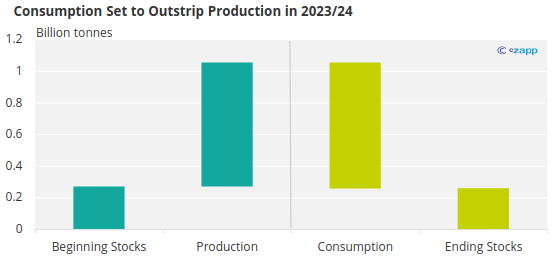
Source: WASDE
Only the corn crop is larger, at an estimated 1.3 billion tonnes.
Winter or Spring
Wheat is planted either in the winter/autumn months or during the spring. Thus, varieties are referred to as ‘winter’ or ‘spring’ wheats.
The winter planted crops will be harvested in mid-summer with the spring harvested in the late summer or early autumn.
Winter wheat can be considered as the endurance athlete, with a much longer growing season, while spring wheat is more of a sprinter.
Winter varieties are sown ahead of any harsh winter and plants establish a green carpet over the fields.
The crop then lies dormant in the extreme cold of winter. As the warmer temperatures of spring arrive, the plant spurs into growth action, reaching maturity for harvest in summer.
Spring varieties are planted into the warming soil temperatures in spring, ideal for germination. Plants then race out of the ground for a rapid sprint to harvest in the latter months of summer.
Hard or Soft Wheat
As the names suggest, the critical difference between hard and soft wheat is the hardness or ‘resistance to the physical forces of compression’.
Hard wheat can be higher in protein and gluten content than soft wheat. Most spring wheat is hard and the best quality.
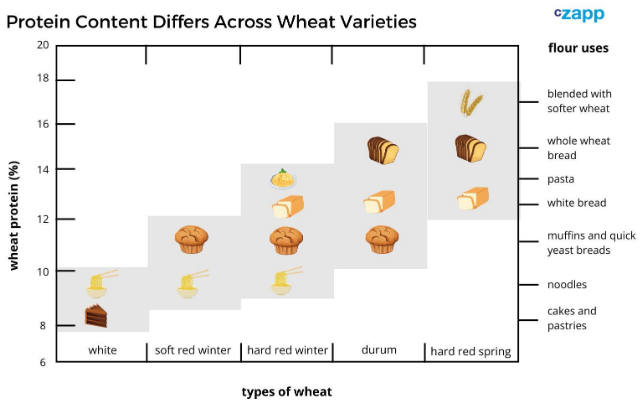
Soft wheat has greater levels of starch.
When milled into flour for human consumption, hard wheat flour is coarser, making it sieve more easily than soft wheat flour, which is finer.
What is Wheat Used For?
Wheat is used to feed people, livestock and has a small number of industrial uses. Many processes for human consumption require distinct quality specifications.
The best quality hard wheats are often spring wheat, although there are many good varieties of winter wheat suitable for bread making. That being said, lower quality milling and feed wheats will generally be winter wheats.
The higher protein and gluten levels found in good quality hard wheats suit their uses in bread flour. We also see hard wheats used in the production of tortillas, noodles and other goods.
Soft wheat varieties are more suited to producing flour for cookies, cakes, doughnuts, pastries, flat breads and crackers.
Livestock are less fussy than us humans, so any hard or soft wheat is usually used in their feed.
There are a few rules of thumb to follow:
- Higher protein, specialist hard milling wheats will attract the highest prices.
- Lower grade hard wheats and milling grade soft wheats will attract lower prices but are likely to be higher yielding, easier and less costly to grow than the best hard wheat varieties.
- Feed wheats are generally the simplest and cheapest to grow, as well as the highest yielding, but attract the lowest prices.
Planting and Harvest
The table below shows planting and harvest periods around the world.
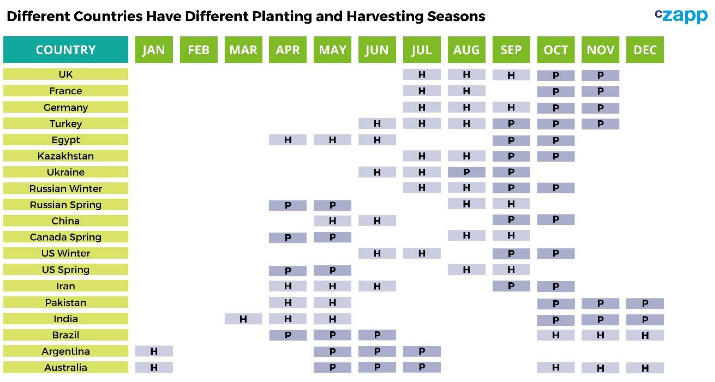
Trade Flows
The improvements in communication and logistics over time have created an incredibly smooth supply chain for wheat around the world. This has been highlighted by the disruption to exports through the Black Sea, a consequence of Russia’s invasion of the Ukraine, which have been significant to many of the largest players — both exporters and importers.
The tables below show who the most significant players are in the production, consumption and trade of wheat from every corner of the world.
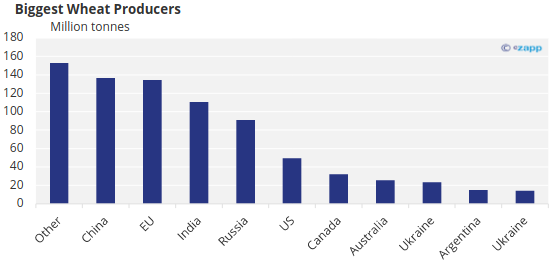
Source: WASDE
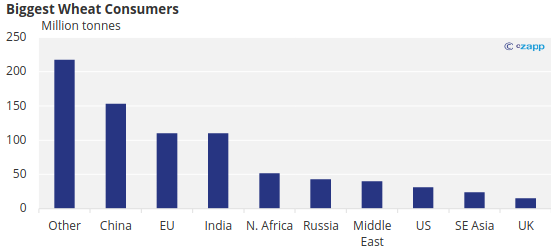
Note: North Africa includes Algeria, Egypt, Libya, Morocco, Nigeria & Tunisia; Middle East includes Lebanon, Iraq, Iran, Israel, Jordan, Kuwait, Saudi Arabia, Yemen, UAE & Oman; Southeast Asia includes Indonesia, Malasia, Philippines, Thailand & Vietnam.
Source: WASDE

Source: WASDE
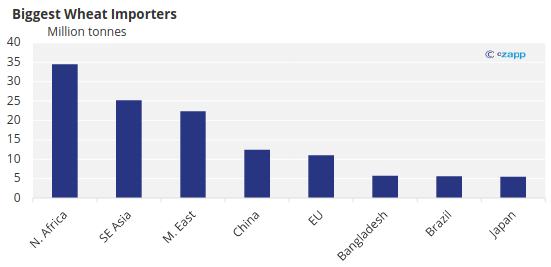
Note: North Africa includes Algeria, Egypt, Libya, Morocco, Nigeria & Tunisia; Middle East includes Lebanon, Iraq, Iran, Israel, Jordan, Kuwait, Saudi Arabia, Yemen, UAE & Oman; Southeast Asia includes Indonesia, Malasia, Philippines, Thailand & Vietnam.
Source: WASDE
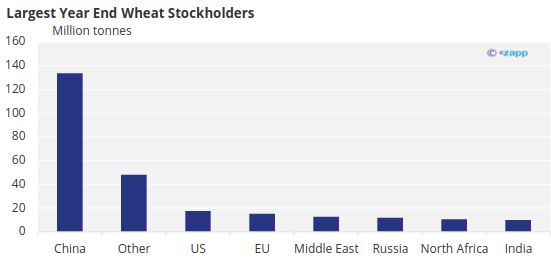
Note: North Africa includes Algeria, Egypt, Libya, Morocco, Nigeria & Tunisia; Middle East includes Lebanon, Iraq, Iran, Israel, Jordan, Kuwait, Saudi Arabia, Yemen, UAE & Oman.
Source: WASDE
Perhaps the most noteworthy numbers in the tables above relate to China. It is:
- The largest producer.
- The largest consumer.
- The largest importing nation (a recent development).
- The largest stockholder with 50% of year end global wheat stocks.
How the Domestic Supply Chain Works
Countries where wheat is both produced and consumed can have relatively short supply chains, from farm growers to the ultimate general public consumers.
An example of a basic short supply chain would be bread purchased in a local bakery:
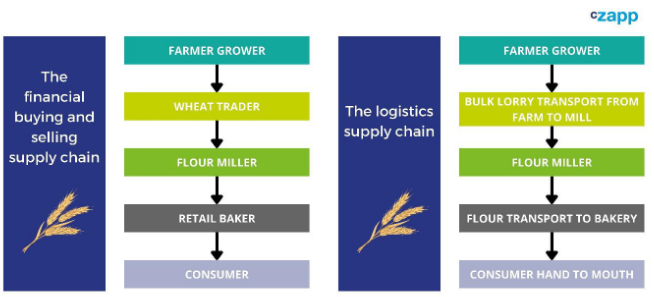
Supply chains can become hugely more complex as extra logistical components come into play. This is particularly the case where shipments from continent to continent are concerned.
In addition, where wheat is destined for livestock consumption, including the feed compounder and processors, there will be many more links in the supply chain before the end product reaches the general public consumer.
Nonetheless the simple local supply chain is common in many of the leading wheat producing and consuming nations in the developed world.
Summary
Wheat is much more than just a simple cereal grain. It has evolved over thousands of years to become a leading staple in diets for most of the world’s population.
It is grown across all but one continent of the world, covering more acres of land than any other grain, while coming second only to corn in tonnes produced.
The growers and users have developed an astoundingly good supply chain, helping to feed many of the poorest across the globe.
Wheat is fascinatingly versatile in its uses whether for indirect food production, through feeding livestock, or directly to the wheat products we enjoy on a daily basis.






